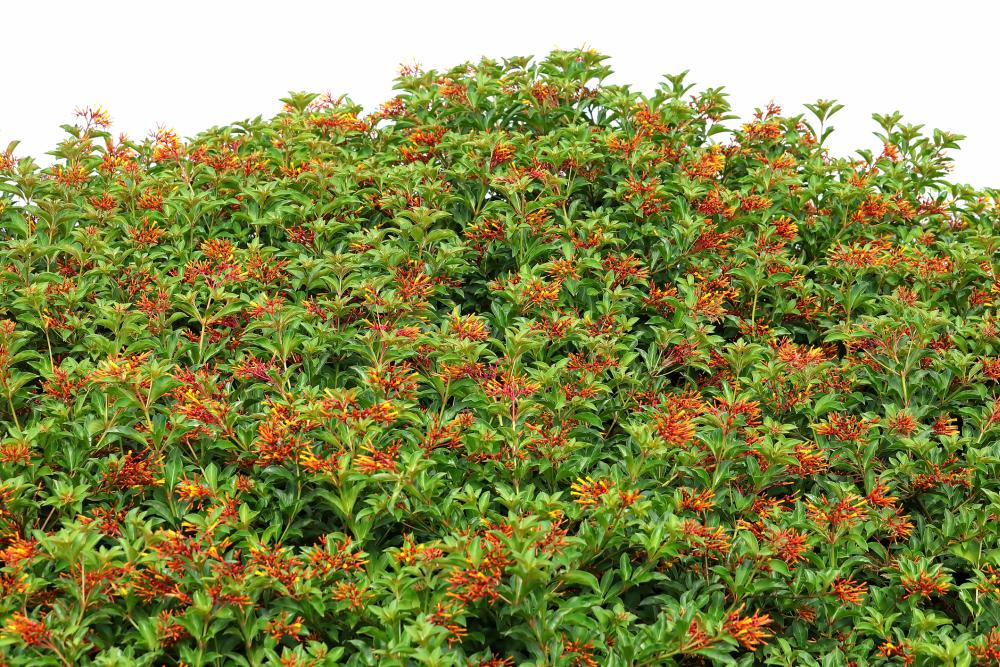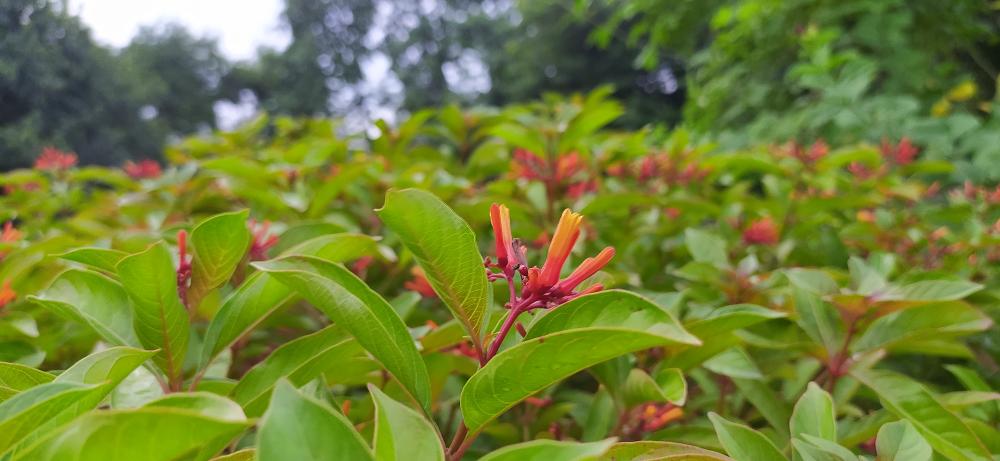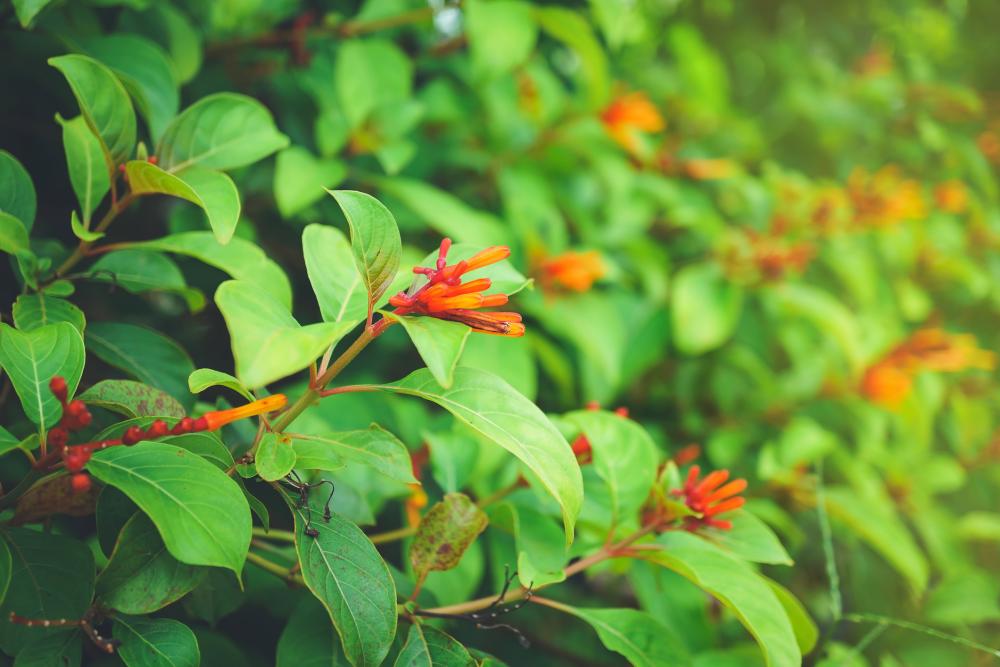6 Firebush Growing Problems And What To Do About Them
Tropical plants are known for their exotic colors and showy flowers. But the firebush takes this to a new level with its bright orange blooms, lush green leaves, and red stems. It’s a carnival of colors where the flowers stay in bloom from the spring to fall every year. What more can one ask of an ornamental plant? Perhaps fewer growing problems?
Because firebush growing problems can be frustrating sometimes. The leaves might drop, or the tropical plant struggles through the cold winter months. Pruning is a crucial part of the tropical plant care which is a daunting task if not done properly and at the right time. This article puts together 6 of the common firebush growing problems and suggests a few solutions for each one.
Firebush Leaf Drop
It’s no secret that flashy leaves can be just as ornamental, if not more, than the flowers. Just try to imagine a plant without leaves but only blooms. It immediately loses a few points on the ornamental scale. And while it’s normal for plants to shed a few leaves during the growing season for various reasons, this becomes a problem if the shedding is regular and increases over time.
Firebush leaf drop can become a serious problem if you see as many leaves on the ground as on the plant itself. And the reasons for this unhealthy phenomenon vary. But they mostly have to do with the care you provide and the growing conditions around the plant rather than diseases or infections. Most often the plant is dehydrated, stressed or in shock, or is struggling with too much water. Using the wrong fertilizer in excessive amounts can also trigger a massive leaf drop.
How to Fix It
When you have so many reasons to deal with, you will need to go through each one at a time and try to remedy it. If the leaves stop dropping, then you know you have found the cause. If not, then you continue with the rest of the list. Here are a few things you can do to stop leaf drop of firebush plants.
- Shock: The firebush is a sensitive plant. Any changes in the weather or the soil can give it a fright and cause the leaves to fall. Sudden changes in temperature either rising or falling can trigger it. Also dividing the plant or digging around the roots can cause a shock. In these cases, wait for the plant to regain its composure and grow back the lost leaves.
- Too Much Water: Wet soil often means less oxygen. When the roots fail to absorb enough oxygen, the leaves will drop. So allow the soil to dry out between irrigations. And always water deep to encourage the roots to grow deeper in the soil.
- Not Enough Water: Few plants can deal with dry soil and lack of moisture. Most tropical plants are accustomed to above-average rainfall every year so they have little tolerance to drought. If you forget to water your firebush, the leaves will turn yellow and drop. Water the plant once or twice a week and give it around one inch of water per week during the growing season.
- Feeding: Although not a heavy feeder, the firebush still needs nutrients in the soil. Apply a general-purpose fertilizer once a year in the spring. Too much fertilizer can damage the plant.
Firebush Container Care
Most often than not, you’ll find yourself growing tropical plants in containers rather than in the garden. Container growing has many advantages. It takes less space, allows you to move the plants around to get more sun, and makes wintering the plants a lot easier.
But not all plants do well in containers. Root bound for example, is a serious problem for plants with robust root systems. And for a shrub like the firebush, you’ll need to do more pruning than normal just to keep the plant manageable. But that’s just one part of the problem. Choosing the right container size to start the plant and increasing it as you repot it should also feature high on your priorities. So how can you grow and care for the firebush shrub in a container?
How to Fix It
So you’ll start with a 12-inch terra-cotta pot with plenty of drainage holes at the bottom. Since the plant cannot stand waterlogged soil, you’ll need to use a well-drained and sterilized potting mix. If you want to make your own potting mix, add perlite to garden soil in equal parts and mix in some organic materials.
Place the container in a sunny spot facing the west or south. Keep the plant sheltered from any chilled winds. Water the container between 2 to 3 times a week and don’t let the soil dry out completely.
Prune the tree regularly in the late winter and pinch off the tips of the branches to encourage a bushy look. You can cut the established bush back by about one-third to keep it compact.
Firebush Winter Care
If you ask any gardener about the one thing they worry about the most when growing tropical plants, the answer will invariably be winter care. Although in theory, you can grow firebush shrubs in zones 8 and above, the cold winter of zone 8 can be brutal for the shrub.
If you don’t prepare the shrub for the winter, there’s little chance it would survive the frost. Not to mention that low temperatures leave an indelible mark on the foliage. From leaves turning color and dropping to the plant looking stressed and becoming stunted. So how would you protect your firebush from the coming winter and make sure it thrives?
How to Fix It
If you’re growing the firebush shrub in a container, then your winter care is limited to the regular annual pruning and bringing the plant indoors where it’s warm. Cut down watering by half and don’t feed it at all. When the last frost is over, take the shrub outside gradually.
If you live in zones 8 and under and don’t want to grow the firebush shrub in a container, your only option is to grow it annually. There’s little you can do to keep it alive during the winter. But since the plant has a fast growth rate and will bloom in the first year, then planting a new shrub every year doesn’t sound like a bad option. When the last flower has dropped in the fall, dig out the plant and use the leaves as mulch or compost.
Firebush Cutting Propagation
If you have to plant a new firebush shrub every year because the tropical plant cannot handle your harsh winter months, then you’ll need to learn about firebush cutting propagation. It will save you the trouble of going through the lengthy and complicated process of starting the shrub from seeds. And since all you need is a 6-inch stem from a healthy shrub, you can keep yourself supplied indefinitely as you extract a few branches from the annual shrub before you drop it in the compost pile. But learning how and when to propagate the firebush from cutting is important for the success of the plant.
How to Fix It
Timing has to be right in order for the cutting to develop roots. If you start it too early, it might freeze over, and if you start it late in the spring, it won’t have time to grow and blossom before the end of the summer. Here’s how to propagate the shrub from cutting in easy steps.
- Select a few healthy stems from a shrub and cut 6 inches of each stem.
- Remove the lower leaves and keep only a few leaves at the top of the cutting.
- Fill a pot with general-purpose potting mix or mix your own with perlite and regular soil.
- Dip the cutting in rooting hormone to encourage root development
- Shake off the excess powder and plant the cutting in the soil 2 inches deep.
- Firm the soil around the cutting to keep it standing upright.
- Water the soil to get it moist.
- Keep the pot on a heat mat and set it to 75 degrees F.
- You can keep the plant growing indoors until the threat of the last frost is over then transplant it in the garden.
Firebush Pruning
The topic of firebush pruning came up a few times while covering many of the firebush growing problems. Lack of pruning not only gives the shrub an unpleasant look, but it can make it unmanageable. If you’re growing the shrub in a container, then you’ll need to take pruning more seriously if you want to give it compact size.
But as you’ll soon find out, pruning firebush shrubs can be a daunting task. It’s never as easy as you see on Youtube videos and there are many ways you could go wrong and give the shrub a scar that is hard to fix.
How to Fix It
You can start pruning the firebush shrub in the late winter or early spring before the first signs of growth. When in doubt, you can start the process in the late winter to avoid removing flower buds which usually appear early on the branches.
Cut back about one-third of the shrub in one go. Always choose the thickest of the branches to remove first since that triggers the new growth of young shoots in the next spring. This will also prevent the shrub from outgrowing the container.
Experts recommend that you keep the shrub under 6 feet tall to have an abundance of blooms throughout the spring all the way to the fall.
Firebush Transplanting
Depending on where you live and the microclimate you grow the firebush shrub in, you might need to transplant the tropical plant regularly. For example, if you’re growing it as an annual shrub, then you’ll have to start it indoors then transplant it when the weather warms up.
Of course growing the shrub in a container can save you a lot of hassle, but that may not be possible for everyone. And because this shrub is quite sensitive, dividing or transplanting it can give it a shock where it will start losing its leaves. So you’ll have to treat the plant with the dexterity of a neurosurgeon.
How to Fix It
The process of transplanting a mature and established firebush shrub is a lengthy one. You usually will start preparing the plant for it in the fall and transplant it the next spring. Or you could start in the spring and transplant it in the fall. The idea is to allow enough time for the plant to get used to the changes you introduce it to.
Start by tying up the lower branches of the firebush then prune the roots. Dig a narrow trench around the perimeter of the shrub and use a sharp blade to cut the ends of the roots. Refill the trench and wait for a few months.
When you’re ready to transplant the shrub, dig another trench a little wider than the previous one. Rock the shrub from one side to the other as you push a shovel deep under the root ball. Dig up the shrub and plant it in a hole the same depth as the original one. Water the shrub immediately to help the soil settle.


